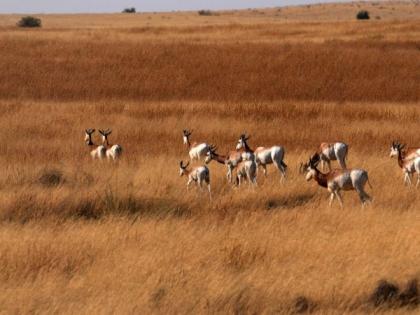EAD starts first reintroduction phase of Dama Gazelles in Chad
By ANI | Published: May 16, 2024 11:42 PM2024-05-16T23:42:50+5:302024-05-16T23:45:10+5:30
Dubai [UAE], May 16 (ANI/WAM): As part of one of the largest large mammal reintroduction programmes in the world, ...

EAD starts first reintroduction phase of Dama Gazelles in Chad
Dubai [UAE], May 16 (ANI/WAM): As part of one of the largest large mammal reintroduction programmes in the world, the Environment Agency - Abu Dhabi (EAD) released for the first time six Dama Gazelles into the Ouadi Rime - Ouadi Achim Wildlife Reserve (OROAWF) in Chad. One of the three most endangered gazelle species, this latest release is part of an ambitious initiative to increase Dama Gazelle numbers in the wild.
Classified on the International Union for the Conservation of Nature (IUCN) Red List of Threatened Species as 'Critically Endangered' (extreme risk of extinction), with only about 100 Dama Gazelles remaining in the wild in Chad and Niger, the species is on the verge of extinction, and efforts are underway to both preserve and increase wild herd numbers in its natural habitats.
"The project began in 2019 for this species with a captive breeding programme, when the team succeeded in capturing a group of five wild gazelles in the Manga region and other areas of Ouadi Rime - Ouadi Achim in Chad," said Ahmed Al Hashemi, Executive Director of the Terrestrial and Marine Biodiversity Sector at EAD. "They were then transported to enclosures for breeding and reached, where they were kept with other Dama Gazelles located from EAD's wildlife conservation centres in Abu Dhabi to Chad. The numbers have multiplied since then to a total of 29 animals."
He added, "The animals released by EAD are from two groups: one wild and the other captive-bred. Three animals were equipped with satellite tracking devices by a joint team from EAD, Sahara Conservation, the Smithsonian's National Zoo and Conservation Biology Institute, and the Zoological Society of London, to follow their movements and monitor their progress in the reserve, which is home to about 50 Dama Gazelle. This is also the first time that the captive-bred gazelles at the OROAWF reserve are being monitored using satellite collars."
"The post-release monitoring of gazelles will help us provide detailed information about the reproduction and mortality rates of these animals," Al Hashemi added. "It also provides a unique opportunity to closely monitor wild Dama Gazelles, and to identify factors that limit their reproduction. This, in turn, will support this gazelle species in the long term. It will also contribute to increasing the reserve's Dama Gazelle herd, and provide basic information for future releases, such as the best tracking devices to use and establishing the most effective wild herd monitoring practices."
The reintroduction of the Dama Gazelle follows the successful reintroduction programmes for the Scimitar-horned Oryx (SHO) and the Addax in Chad, which are part of an ambitious initiative that aims to establish a healthy and self-sustainable herd in an isolated, 77,950-square kilometre natural protected area within the Ouadi Rime - Ouadi Achim reserve.
Launched in 2014, the first group of SHO were released into their natural habitat in 2016. The wild herd were monitored to ensure that they were in a good, healthy condition, and able to adapt well to their new surroundings. Today, there are over 630 SHO flourishing in the reserve, with 160 healthy Addax.
The Agency's joint efforts with its SHO reintroduction programme partners in Chad have resulted in improving the species' conservation status, which was reclassified as 'Endangered' on the IUCN's Red List of Threatened Species, after having previously been classified as 'Extinct in the Wild'. (ANI/WAM)
Disclaimer: This post has been auto-published from an agency feed without any modifications to the text and has not been reviewed by an editor
Open in app